Alocasia plants, known for their striking, arrow-shaped leaves, have become a favorite among houseplant enthusiasts. Their unique, tropical appeal can transform any space into an indoor oasis.
However, the common issue of Alocasia leaves curling may have left you puzzled and concerned.
This phenomenon, while not uncommon, can signal several potential problems, from incorrect watering to pest infestations.
This article delves into the causes behind your Alocasia’s curled leaves and provides practical solutions to bring your plant back to optimal health.
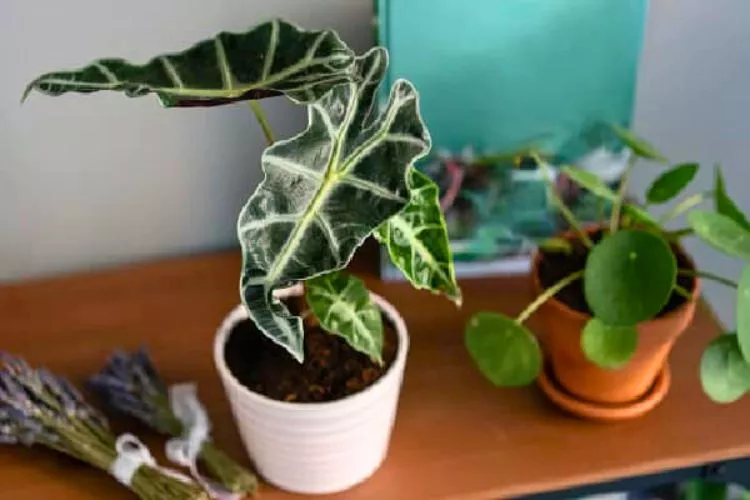
Whether you’re a novice plant parent or an experienced green thumb, this guide will help demystify this perplexing issue and ensure your Alocasia thrives.
Table of Contents
Understanding Alocasia Plants
Alocasia plants, often called Elephant Ears plants due to their large, heart-shaped leaves, originate from the tropical rainforests of Southeast Asia.
They belong to the Araceae family and boast over 80 stunning species, each with unique features that make them a captivating addition to any plant collection.
Among the most popular varieties are Alocasia Polly, known for its deep green, glossy leaves with sharply contrasting veins, and Alocasia Zebrina, easily recognized by its zebra-patterned stems.
Alocasia Macrorrhizos, or Giant Taro, impresses its enormous foliage, while Alocasia Black Velvet charms with its dark, velvety leaves.
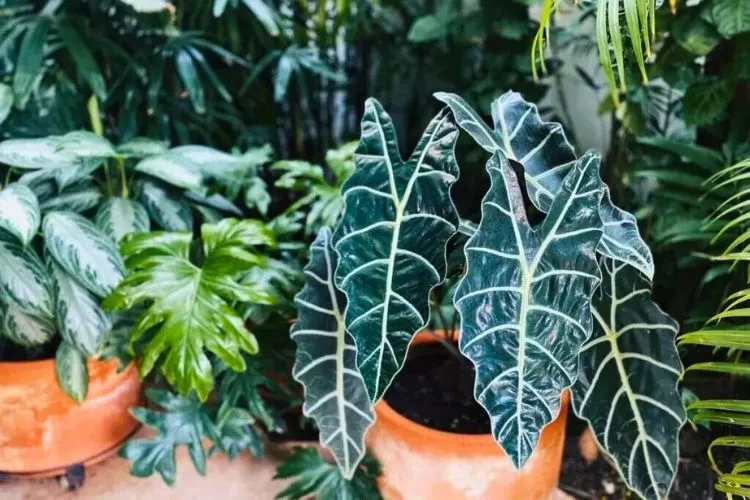
These plants are fond of warm, humid conditions like their native tropical habitats. They thrive best in bright, indirect light, as direct sunlight can scorch their delicate leaves.
As for temperature, they prefer a range of 60-85°F (15-29°C), with humidity levels of 50% or higher. Alocasia plants also require well-draining soil to prevent waterlogging and root rot.
Understanding your Alocasia’s preferences is the first step towards addressing any leaf curling issues. In the following sections, we’ll dive deeper into the specifics.
6 Causes of Alocasia Leaves Curling
When you notice your Alocasia leaves curling, it’s your plant telling you something’s amiss.
Several factors could lead to this, ranging from watering issues and unsuitable environmental conditions to pest infestations and nutrient deficiencies.
Let’s delve deeper into these causes and understand how they affect your Alocasia.
Insufficient Watering
Water is vital to Alocasia plants, acting as a transport medium for nutrients and aiding photosynthesis. However, underwatering can lead to dehydration, causing the leaves to curl to minimize water loss.
Signs of underwatering include dry, brittle leaves that often curl at the edges. The soil may feel dry to the touch, even several inches below the surface. You might notice a slow growth rate and wilting, especially during peak sunlight hours.
For example, If you water your Alocasia once every two weeks in a warm, dry environment, the plant may not be getting enough hydration.
You might need to adjust your watering schedule to once a week or monitor soil moisture levels more closely.
Overwatering
Conversely, giving your Alocasia too much water can also lead to leaf curling. Overwatering can cause the plant’s roots to become waterlogged and oxygen-starved, leading to root rot—a condition as ominous as it sounds.
Root rot can cause your Alocasia leaves to curl, turn yellow, and eventually fall off.
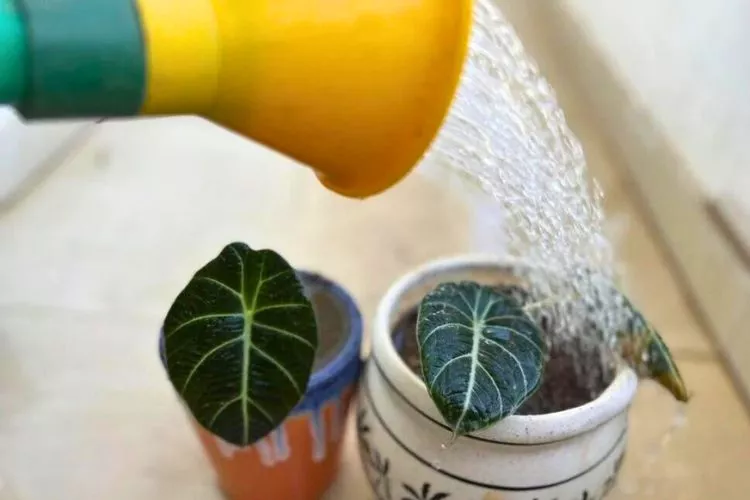
Suppose you’re keeping your Alocasia in a waterlogged condition and notice the leaves turning yellow before curling.
In that case, it’s a clear sign of overwatering and the possible onset of root rot. A balance in watering is key to keeping your Alocasia happy.
Temperature and Humidity
Alocasia plants prefer a warm and humid environment, similar to their tropical origins. They thrive in temperatures between 60-85°F (15-29°C) and 50% or higher humidity levels.
When the temperature drops significantly, or the air becomes too dry, you might see your Alocasia leaves curling.
For example, if you place your Alocasia near a drafty window in winter or an air-conditioned room, the cold and dry conditions could cause leaf curling. Ensuring the right temperature and humidity conditions are vital for your Alocasia’s well-being.
Lighting Conditions
Light plays a pivotal role in the health of your Alocasia. These plants love bright, indirect light. Too little light and the plant might not have enough energy for growth, leading to weak, curling leaves.
Conversely, direct sunlight can scorch the leaves, causing them to curl and develop unsightly brown spots.
If your Alocasia is kept in a dimly lit corner or exposed to harsh afternoon sun, it may show signs of distress through curled leaves. Proper lighting conditions are crucial for keeping your Alocasia vibrant and healthy.
Pest Infestation
Pests are a common enemy of houseplants, and Alocasia is no exception. Common culprits include:
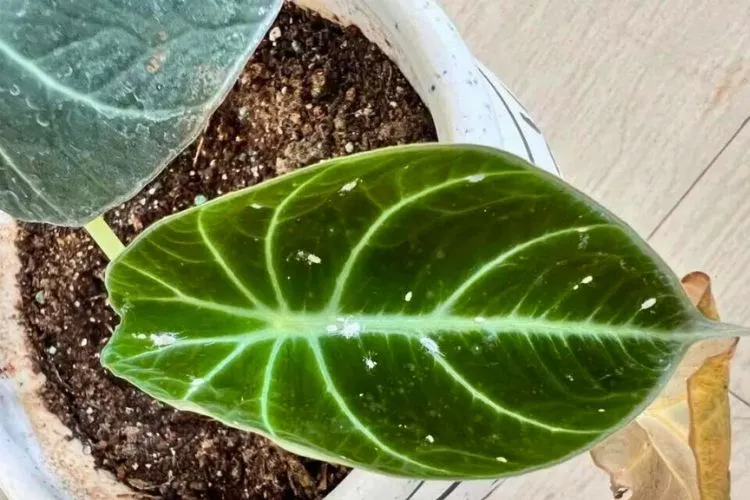
Spider Mites
Spider mites are tiny, spider-like creatures that are often hard to spot with the naked eye. They suck sap from plant leaves, causing yellow or brown spots and, in severe cases, leaf curling. You might also see fine webs on your Alocasia if spider mites are present.
Aphids
Aphids are small, green, or black insects that feed on plant sap. They cause yellowing, curling, and wilting leaves. A sticky substance known as honeydew often accompanies aphid infestations, attracting sooty mold.
Mealybugs
Mealybugs are white, cottony pests that cluster in leaf axils, undersides of leaves, and around new growth. They feed on plant juices, causing yellowing and curling of leaves. They also excrete honeydew, which can lead to sooty mold growth.
Nutrient Deficiencies
Alocasias need a balanced supply of nutrients for healthy growth. Deficiencies in macronutrients like nitrogen, phosphorus, and potassium can lead to leaf curling. Let’s have a look at them in detail:
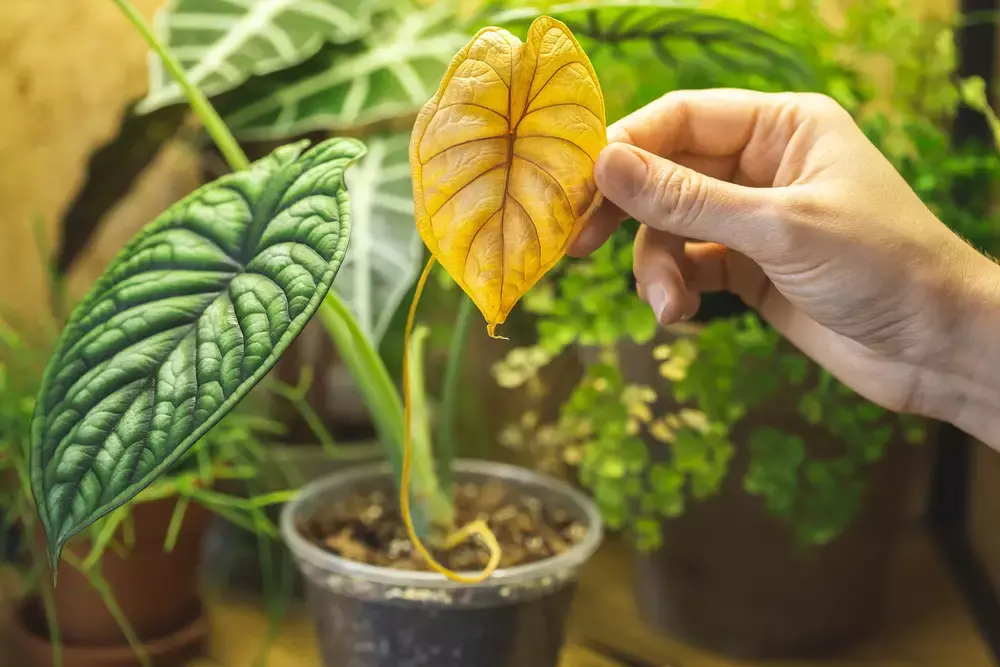
Nitrogen
Nitrogen is vital for leaf and stems growth in Alocasia. A deficiency results in yellowing leaves, starting with the older, lower leaves. The plant’s growth may also slow down.
Phosphorus
Phosphoruwith s is essential for energy transfer in plants. A deficiency often manifests as dark green foliage purple discoloration on the undersides of leaves. Curling may occur in severe cases.
Potassium
Potassium aids in protein synthesis and water regulation in plants. A potassium deficiency in Alocasia plants can lead to curling leaf edges that eventually turn brown. You may also notice a general weakness in the plant.
Excess Nutrients
Conversely, too much of any nutrient can also harm your Alocasia. Excess nutrients can cause salt build-up in the soil, leading to leaf burn and curling. Always follow the recommended fertilizer dosage and frequency to avoid this problem.
How to Fix the Curling Issue With Remedies and Preventive Measures
Now that we’ve identified the common causes of Alocasia leaves curling, let’s dive into the remedies and preventive measures to help your plant flourish.
Watering Techniques
As we’ve seen, both overwatering and underwatering can lead to leaf curling. The key here is balance. Your Alocasia should be watered regularly, but the soil should dry out slightly between watering.
A general rule of thumb is to water when the soil’s top 1-2 inches (2.5-5 cm) are dry.
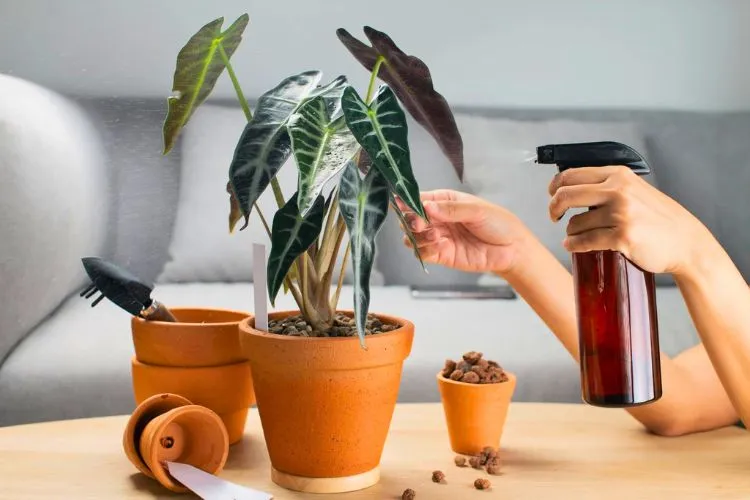
Choosing a pot with sufficient drainage holes is crucial to prevent waterlogging, and using well-draining soil will also help prevent root rot. A soil mixture that includes perlite or coarse sand can provide excellent drainage.
For example, if you find your plant’s leaves curling due to underwatering, try increasing your watering frequency. Conversely, if overwatering is the issue, reduce watering and ensure excess water can drain away easily.
Adjusting Environmental Factors
Maintaining suitable temperature and humidity levels is essential for your Alocasia’s well-being. Tropical plants prefer temperatures between 60-85°F (15-29°C) and humidity levels of 50% or higher.
If your home’s humidity level is lower, especially during winter, consider using a humidifier or placing a pebble tray filled with water under your plant to increase humidity. Proper ventilation can also help prevent fungal diseases that can cause leaf curling.
Lighting Modifications
As for lighting, Alocasias thrive in bright, indirect light. Too much direct sunlight can scorch the leaves, while too little light can hinder growth.
If your plant receives too much light, consider relocating it to a spot with filtered light or use a sheer curtain to reduce light intensity. If lack of light is the issue, a south-facing window or supplemental grow light may be beneficial.
Pest Control
Regular inspection of your Alocasia can help catch pest infestations early. If you spot pests, remove them using a soft cloth and soapy water, or consider using organic or chemical pest control methods.
Always test any treatment on a small part of the plant first to avoid damaging the leaves.
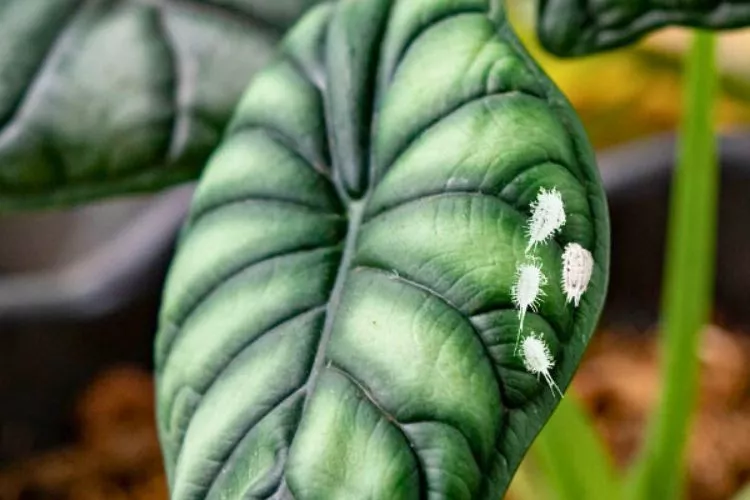
Nutrient Management
Proper nutrition is essential for your Alocasia’s health. They benefit from a balanced liquid fertilizer during the growing season.
Signs of nutrient deficiency, such as yellowing leaves (nitrogen deficiency) or curling leaf edges (potassium deficiency), could indicate the need to change your fertilizing regimen.
Remember, it’s better to under-fertilize than over-fertilize. Too much fertilizer can cause salt build-up in the soil, leading to root burn and leaf curling. If you suspect your plant has been over-fertilized, flush the soil with water to remove excess salts.
In the end, caring for an Alocasia plant is a rewarding journey. Although you might face challenges like leaf curling along the way, understanding the causes and solutions can make the experience all the more enriching.
Frequently Asked Questions (FAQs)
What is the ideal temperature range for Alocasia plants?
The ideal temperature range for Alocasia plants is between 60-85°F (15-29°C). These tropical plants prefer warmer temperatures for optimal growth.
Are Alocasia plants prone to specific pests that cause leaf curling?
Yes, Alocasia plants can be prone to pests like spider mites, aphids, and mealybugs. These pests can stress the plant, leading to symptoms like leaf curling.
Should I repot my Alocasia plant if the leaves are curling?
It depends on the cause of the leaf curling. If it’s due to root rot from overwatering, then repotting with fresh, well-draining soil can be beneficial. However, ensure to address the root cause to prevent recurring issues.
Conclusion:
In wrapping up, we’ve taken a deep dive into the intriguing world of Alocasia plants, their unique features, and optimal growing conditions.
Most importantly, we’ve dissected the prevalent issue of leaf curling, exploring its various causes, from watering missteps, light, temperature, and humidity fluctuations, pest attacks, and nutrient deficiencies.
To keep your Alocasia thriving, providing it with the right care and maintenance is paramount. Keep a close eye on watering, light, temperature, and humidity levels, stay vigilant for pests, and ensure your plant gets the nutrients it needs.
We encourage you to apply the remedies and preventive measures we’ve discussed.
We hope that this guide on Alocasia leaves curling has been helpful. You can read about similar topics here on our website. Check back again soon for more. Happy gardening!


